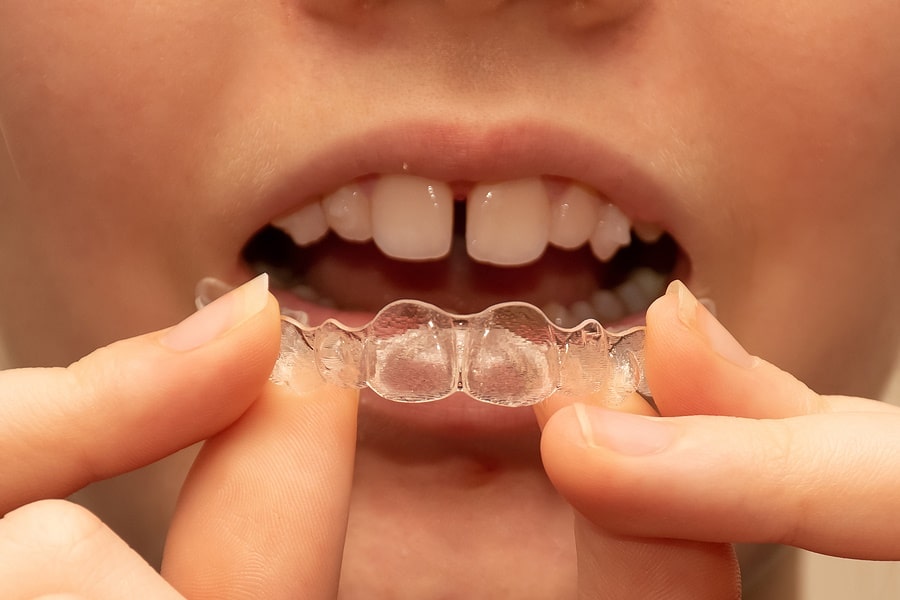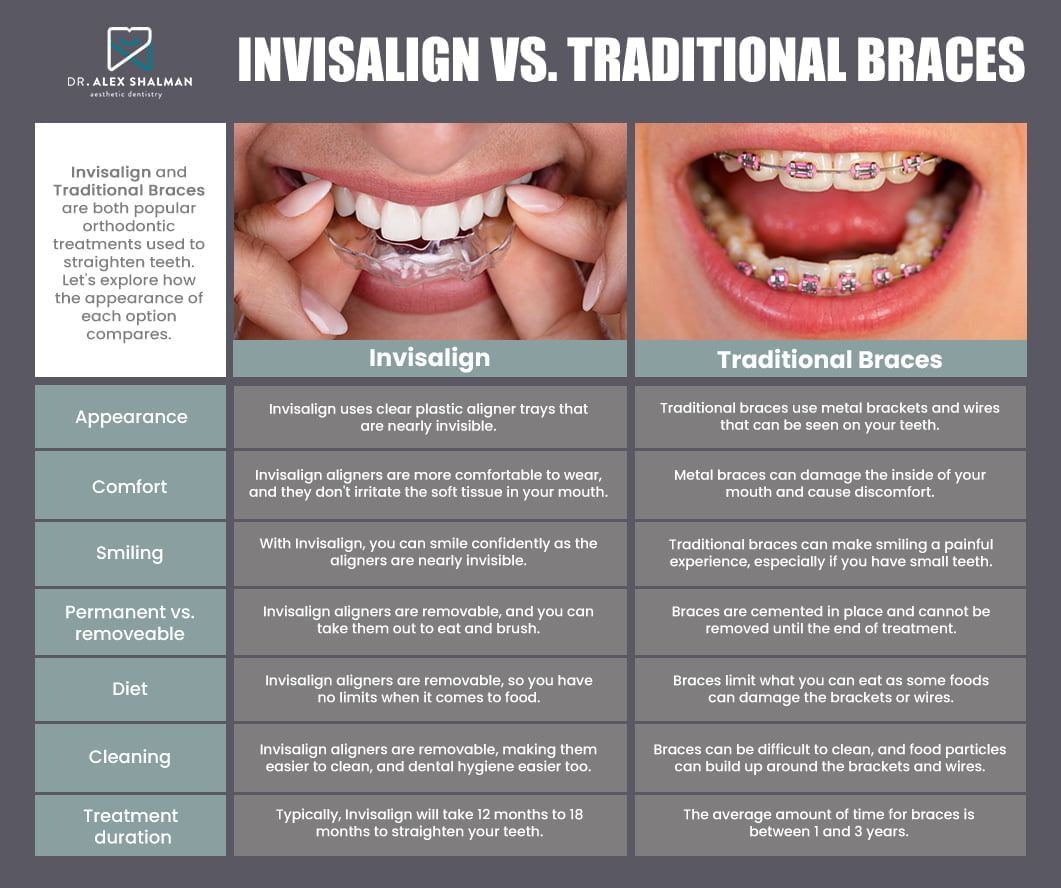What to Expect During Your Invisalign Journey: A Comprehensive Summary
What to Expect During Your Invisalign Journey: A Comprehensive Summary
Blog Article
Invisalign vs. Standard Braces: Which Choice Is Right for You?
When taking into consideration orthodontic treatment, the selection between Invisalign and conventional braces presents a number of important factors that warrant mindful assessment. Invisalign offers a discreet option with removable aligners, while standard braces supply an extra visible yet reliable option for extreme misalignment.
Summary of Therapy Alternatives

On the other hand, standard dental braces contain steel brackets and cords that are bonded to the teeth. This method uses constant pressure in time to achieve positioning. While reliable for intricate orthodontic concerns, typical dental braces need routine check outs for modifications and can pose difficulties in keeping dental hygiene because of the difficulty of cleansing around braces and cords.
Both alternatives have their qualities, and the selection often depends upon particular dental problems, way of living choices, and patient compliance. Eventually, getting in touch with an orthodontic professional is critical for determining the most appropriate treatment plan customized to specific needs. Understanding the nuances of each alternative can significantly influence the overall success of orthodontic therapy.
Visual Factors To Consider
A considerable element influencing the selection in between Invisalign and conventional braces is the visual appeal each therapy supplies. Invisalign aligners are crafted from clear plastic, making them basically unnoticeable when worn.
On the other hand, typical dental braces include metal brackets and wires, which can be much more obvious. While improvements in orthodontic modern technology have actually caused the development of smaller brackets and tinted elastics, traditional braces still keep an even more noticeable account. For some individuals, the visibility of braces may hinder them from looking for necessary therapy.
Ultimately, the choice in between Invisalign and traditional braces might rest on individual preferences concerning appearances. Individuals that focus on discretion often favor Invisalign, while those that are much less worried regarding visibility may decide for typical braces. Understanding the aesthetic effects of each alternative is important for making a notified choice that aligns with one's way of life and choices.
Comfort and Convenience

In regards to ease, Invisalign aligners are removable, enabling individuals to appreciate their favorite foods without constraint and preserve ideal dental health. Brushing and flossing are streamlined, as the aligners can be obtained during these regimens, whereas standard dental braces need mindful steering around braces and wires.
In comparison, standard dental braces require normal adjustments, making them much less hassle-free for those with busy timetables. In general, the convenience and convenience of Invisalign make it an attractive selection for numerous people looking for orthodontic treatment.
Therapy Period and Performance
While both Invisalign and traditional braces work in dealing with dental misalignments, the period of treatment can differ substantially in between the 2 options. Commonly, Invisalign therapy can take anywhere from 12 to 18 months, relying on the intricacy of the instance. The clear aligners work by slowly changing teeth into their desired settings, and regular follow-ups with an orthodontist aid make certain development remains on the right track.
In contrast, traditional dental try here braces frequently require a longer dedication, typically ranging from 18 months to 3 years. This is because of their set nature and making use of cords and braces, which can be more efficient for intricate instances and extreme imbalances (Invisalign). The therapy efficiency of typical dental braces is well-documented, as they permit specific modifications and greater control over tooth motion
Eventually, the selection in between Invisalign and traditional braces may depend upon both the awaited treatment period and the certain dental problems at hand. Consulting with an orthodontist is important, as they can offer tailored referrals based on individual demands, making certain the selected approach lines up with preferred results and timeframes.
Expense Contrast and Insurance Coverage Options
Price plays a considerable role in the decision-making procedure for people thinking about orthodontic treatment, whether choosing Invisalign or traditional dental braces. On average, the cost of Invisalign arrays from $3,000 to $8,000, while traditional dental braces generally cost between $2,000 and $6,000. Elements affecting these prices include the intricacy of the instance, the duration of therapy, and geographical area.
Numerous oral insurance plans offer partial coverage for orthodontic treatments, however the specifics can vary widely. Typically, conventional braces might be more often covered by insurance plans compared to Invisalign, which some insurance providers classify as an aesthetic treatment.
In addition, several orthodontic practices provide versatile layaway plan, making both treatment choices extra easily accessible. People need to inquire regarding prospective financing options and discounts for ahead of time payments. Examining the complete expense, consisting of insurance policy benefits and layaway plan, is vital for making a notified decision that straightens with both aesthetic preferences and budget plan considerations.

Final Thought
In recap, the selection between Invisalign and conventional dental braces hinges on numerous factors, including visual choices, comfort, treatment duration, and cost. Invisalign offers a very discreet, removable option that promotes dental hygiene and nutritional versatility, look at here now while typical dental braces might be a lot more appropriate for complicated dental concerns and frequently come with a lower cost factor. Inevitably, consultation with an orthodontist is crucial to analyze private scenarios you can look here and determine the most appropriate therapy choice for accomplishing optimal dental positioning.
When taking into consideration orthodontic treatment, the choice between Invisalign and typical braces offers several essential elements that warrant mindful analysis.Contrasting Invisalign and conventional braces reveals distinctive therapy choices for orthodontic improvement.While both Invisalign and traditional braces are reliable in dealing with oral misalignments, the period of treatment can vary considerably between the two alternatives.Expense plays a significant function in the decision-making procedure for individuals thinking about orthodontic treatment, whether choosing for Invisalign or traditional dental braces.In summary, the selection between Invisalign and traditional dental braces pivots on several elements, including visual choices, convenience, treatment period, and price.
Report this page